Asteroids and we
The article is not quite a topic for me, but it seemed interesting to tell me about the asteroid danger. In principle, this is a hackneyed topic, but in recent years it has gradually acquired a different content, so I think it will be interesting.
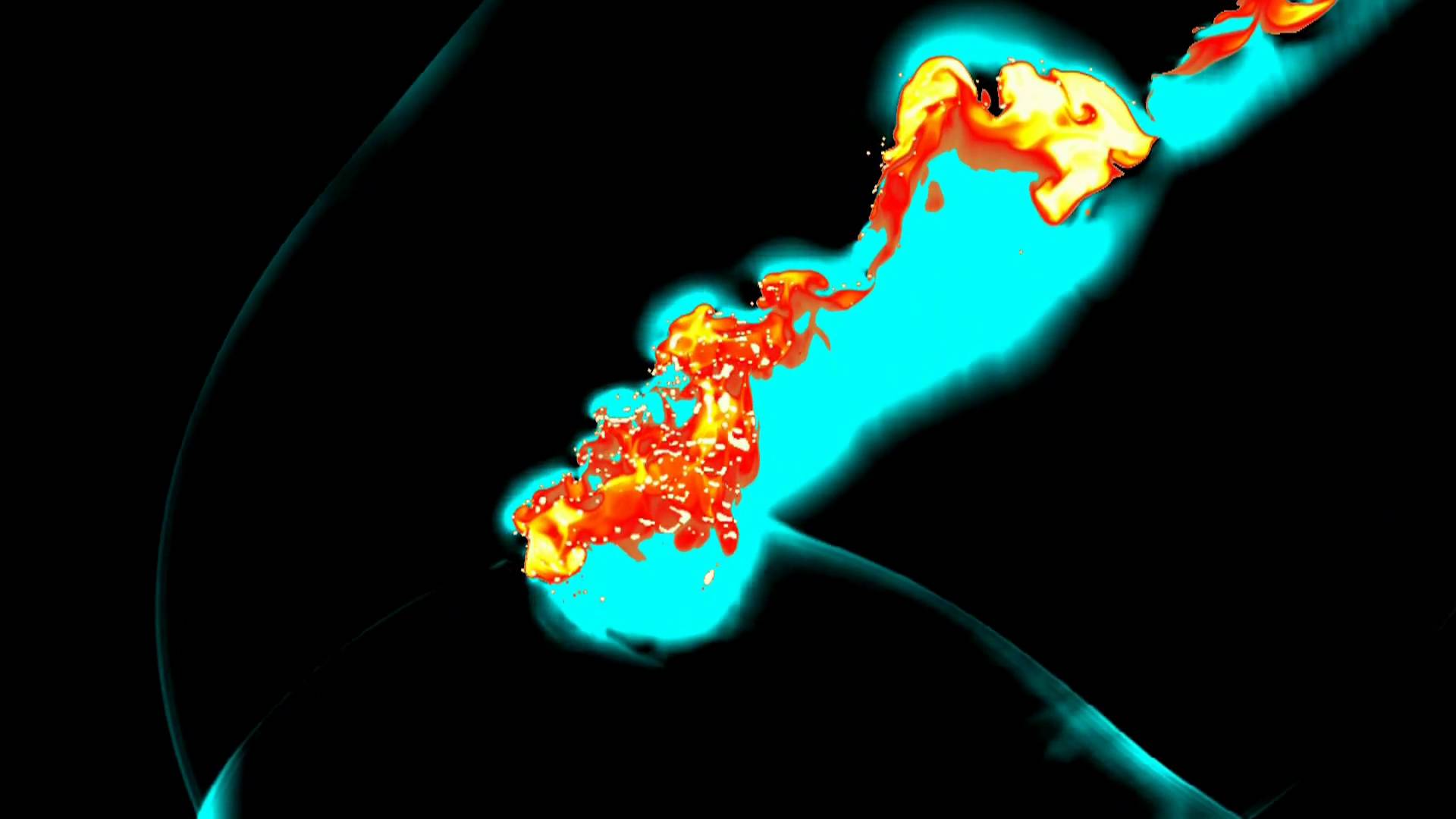
Simulation of the atmospheric explosion of the Tungus meteorite . Current estimates give the power of this impact at 5..15 megatons.
Impact is an asteroid hit (in principle of any size) on the Earth, followed by the release of its kinetic energy in the atmosphere or on the surface. The smaller the impact on energy, the more often it occurs. Impact energy is a good way to determine if a space body is dangerous for the earth or not. The first such threshold is about 100 kilotons of TNT equivalent of energy release, when an incoming asteroid (which, when it enters the atmosphere begins to be called a meteorite) ceases to be limited to falling into YouTube, and begins to bring trouble. A good example of such a threshold event is the 2014 Chelyabinsk meteorite - a small body with characteristic dimensions of 15 ... 20 meters and a mass of ~ 10 thousand tons with its shock wave caused damage to a billion rubles and injured ~ 300 people.
A compilation of the fall of the Chelyabinsk meteorite.
')
However, the Chelyabinsk meteorite aimed very well, and on the whole it didn’t particularly disrupt life even Chelyabinsk, not to mention the whole Earth. The probability of accidentally hitting a densely populated area when colliding with our planet is of the order of a few percent, so the real threshold of dangerous objects begins with a power 1000 times greater - about hundreds of megatons, the characteristic impact energy for bodies of 140-170 meters.
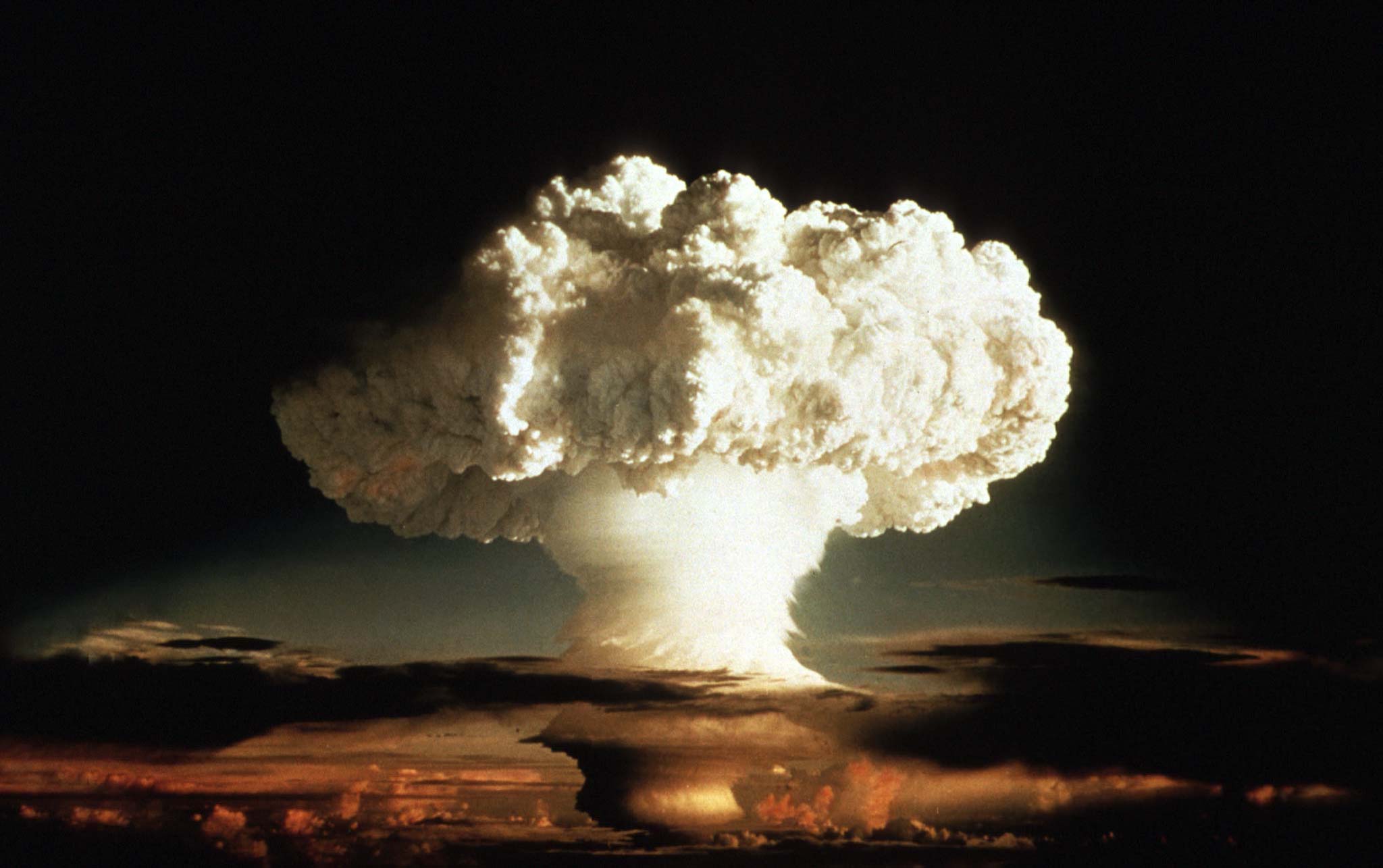
Unlike nuclear weapons, the energy release of meteorites is more blurred in space and time, therefore, slightly less deadly. In the photo - the explosion of a nuclear installation Ivy Mike, 10 megatons.
Such a meteor has a radius of destruction of a hundred kilometers, and successfully landed, it can stop many millions of lives. Of course, there are stones in space and a larger one - a 500 meter asteroid will cause a regional catastrophe, affecting the area thousands of kilometers from where it fell, a half mile away can erase life from a quarter of the planet’s surface, and 10 km will arrange a new mass extinction and precisely destroy civilization.
Now that we have calibrated the Armageddon level by size, we can move on to science.
It is clear that only an asteroid can become an impactor whose orbit will cross the Earth's trajectory in the future. The problem is that you first need to see such an asteroid, then measure its trajectory with sufficient accuracy and model it in the future. Until the 1980s, the number of known asteroids that crossed the Earth’s orbit was dozens of, and none of them were dangerous (did not travel closer than 7.5 million kilometers from the Earth’s orbit when modeling the dynamics, say, 1000 years ahead). Therefore, the study of asteroid danger mainly focused on probabilistic calculations - how many bodies larger than 140 meters can be in orbits crossing the Earth? How often does impact occur? The danger was estimated with probability “in the next decade to get an impact with a capacity of more than 100 megatons is 10 ^ -5”, but the probability does not mean that we will not get a global catastrophe tomorrow.
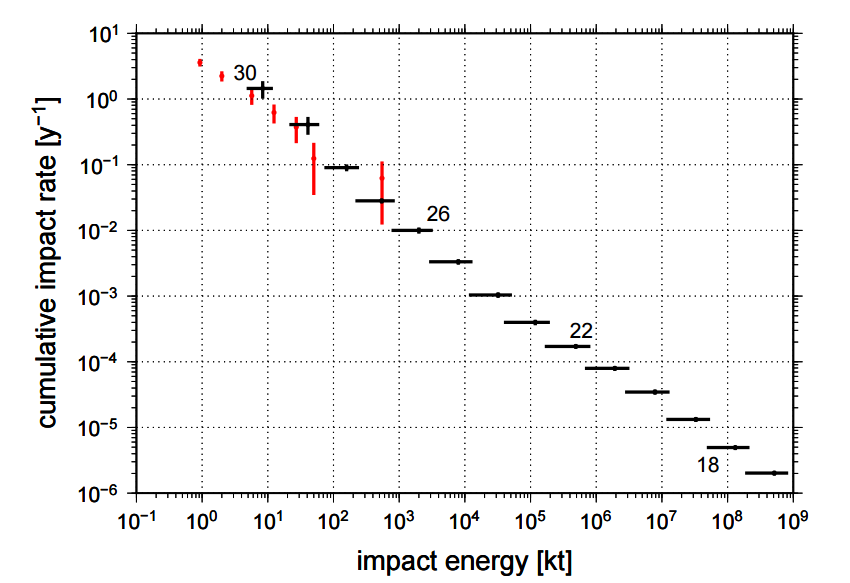
The calculation of the likely frequency of impact depending on the energy. On the vertical axis, the frequency of "cases per year", on the horizontal - the power of impact in kilotons. Horizontal stripes - tolerances by. Red marks - observations of real impacts with an error.
However, qualitative and quantitative growth leads to a rapid increase in the number of near-Earth objects detected. The appearance of telescopes in the 90 CCDs (which increased their sensitivity by 1–1.5 orders of magnitude) and at the same time automatic night sky image processing algorithms led to an increase in the rate of detection of asteroids (including near-earth ones) by two orders of magnitude at the turn of the century.
Good animation of the detection and movement of asteroids from 1982 to 2012. Near-Earth asteroids are marked in red.
In 1998-1999, the LINEAR project comes into operation - two telescopes-robots with an aperture of just 1 meter, equipped with a total of 5 megapixel (later you will understand where “all”) the matrix, with the task of detecting as many asteroids and comets, h near-earth. This was not the first project of this kind (NEAT was quite successful a couple of years earlier), but the first one, specially designed for this task. The telescope was distinguished by the following features, which then become the standard:

The original image (addition of 5 exposures with a cadence of 28 minutes) of the LINEAR telescope and after processing by the algorithm. The red circle is a near-earth asteroid, the yellow circles are the asteroids of the main belt.
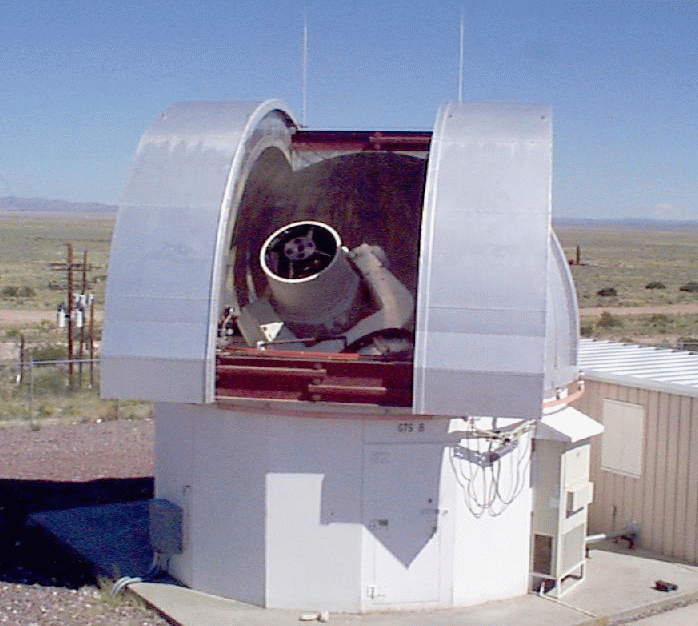
The telescope project LINEAR, located in White Sands, New Mexico.
LINEAR will become the star of the first magnitude of the asteroid search, having discovered 230 thousand asteroids over the next 12 years, including 2300 crossing the Earth's orbit. Thanks to another MPC project ( Minor Planet Center ), information on the asteroid candidates found is distributed to different observatories for additional orbit measurements. In the 2000s, a similar automated survey of the Catalina sky (which will be more focused on the search for near-Earth objects and will find them hundreds per year) comes into operation.

Number of near-earth asteroids detected by different projects by year
Gradually, the estimates of the probability of Armageddon generally begin to yield to the estimates of the probability of death from a particular asteroid. Among the first hundreds, and then thousands of near-Earth asteroids, about 10% are allocated whose orbits are closer than 0.05 astronomical units from the Earth's orbit (about 7.5 million km), while the size of the asteroid must exceed 100-150 meters (the absolute magnitude of the body solar system H> 22).
At the end of 2004, NASA told the world that the asteroid Apophis 99942, discovered at the beginning of the year, with a probability of 1 to 233 will fall into the Earth in 2029. The asteroid, according to modern measurements, has a diameter of about 330 meters and an estimated mass of 40 million tons, which gives about 800 megatons of explosion energy.

Radar image of the asteroid Apophis. Measuring the trajectory with a radar at the Arecibo Observatory allowed the orbit to be refined and the probability of a collision with the Earth excluded.
However, using the example of Apophis, the very probability of a particular body to become an impactor emerged. Knowing the orbit of the asteroid with finite precision and integrating its trajectory again with finite precision, by the time of a potential collision, only an ellipse can be estimated, in which, say, 95% of the possible trajectories will occur. As the Apophis orbital parameters were refined, the ellipse decreased until planet Earth finally fell out of it, and now it is known that on April 13, 2029 the asteroid will pass at least 31200 km from the Earth’s surface (but again, this is the closest edge of the error ellipse).

An illustration of how the tube of possible orbits of the Apophis asteroid shrank at the moment of a possible collision as the orbit parameters were refined. As a result, the Earth was not affected.
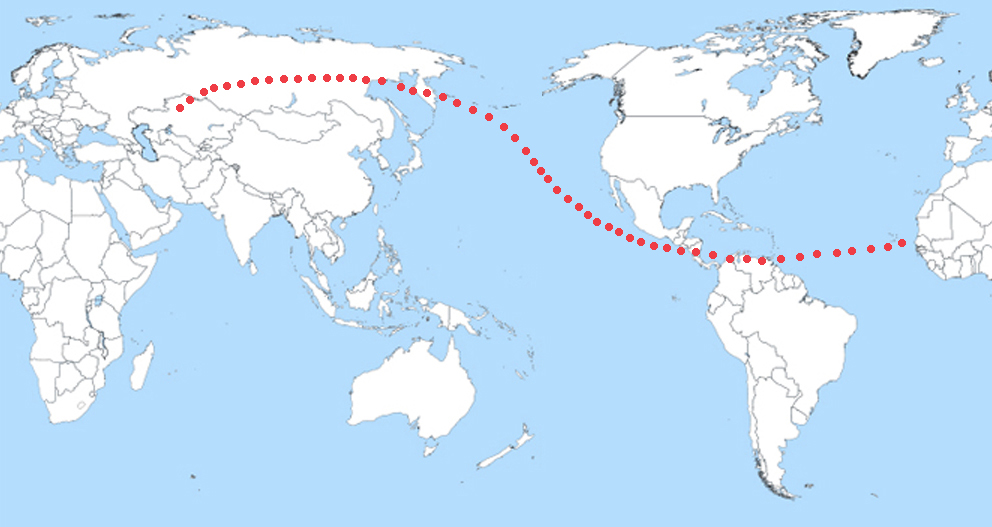
Another interesting illustration of Apophis is the calculation of possible collision points (given the uncertainty) for a collision in 2036. It can be seen, by the way, that the trajectory passed near the site of the fall of the Tungussky meteorite.
By the way, for a quick assessment of the relative danger of near-earth asteroids, two scales were developed - simple Turin and more complex Palermo . Turin simply multiplies the probability of collision and the size of the estimated body, assigning it a value from 0 to 10 (for example, Apophis at the peak of the probability of collision had 4 points), and Palermo calculates the logarithm of the ratio of the probability of impact of a particular body from today to the possible collisions.
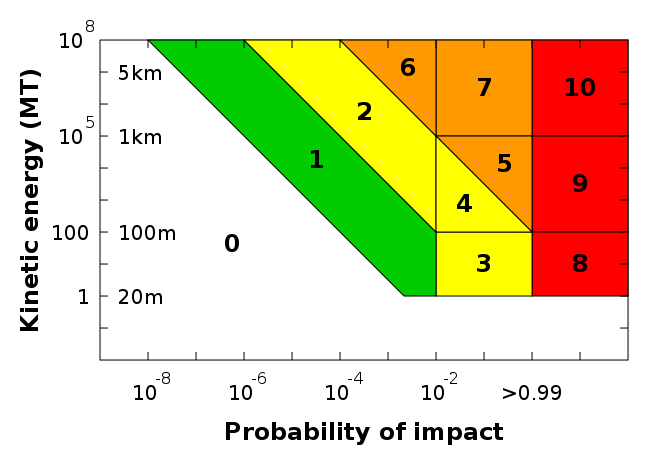
At the same time, positive values on the Palermo scale mean that a single body becomes a more significant potential source of catastrophe than all the others - open and undiscovered together. Another important point of the Palermo scale is the applied convolution of the probability of impact and its energy, giving a rather counterintuitive curve of the degree of risk versus the size of the asteroid - yes, 100 meter stones seem incapable of causing significant damage, but they fall a lot on the whole a greater number of potential victims than 1.5 kilometer “killers of civilizations”.
However, let us return to the history of the detection of near-Earth asteroids and in the middle of them potentially dangerous objects. In 2010, the first Pan-STARRS telescope came into operation, with an extra-wide telescope with an aperture of 1.8 meters, equipped with a matrix of 1,400 megapixels!
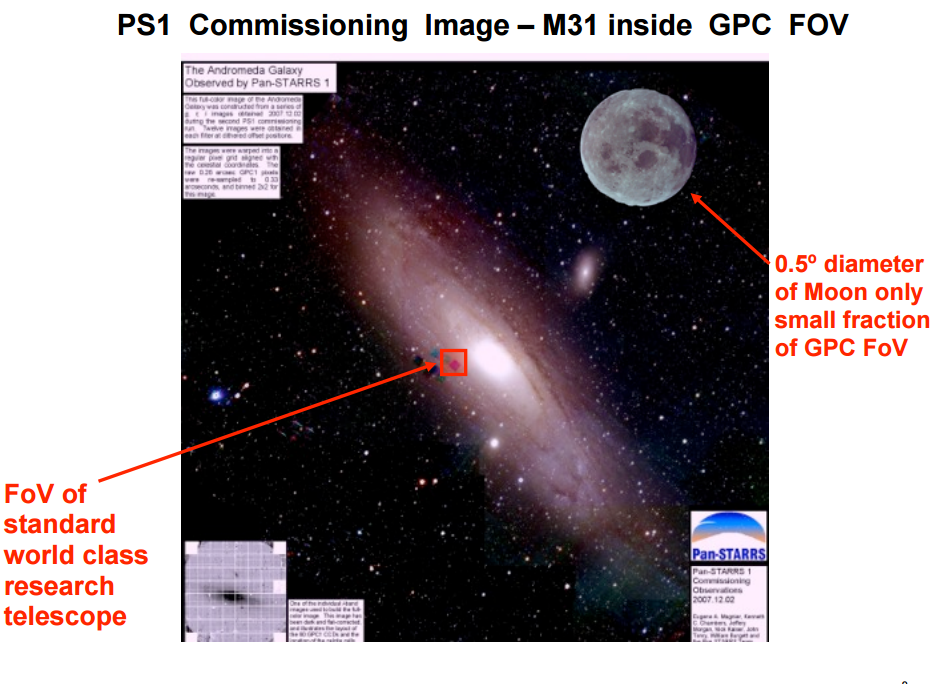
Photo of the Andromeda galaxy from the Pan-STARRS 1 telescope, allowing to evaluate its wide angle. For comparison, a full moon is drawn in the field with colored squares - the “usual” field of view of large astronomical telescopes.
Unlike LINEAR, he takes 30 second shots with a depth of 22 stars. (i.e., it could detect an asteroid measuring 100-150 meters at a distance of 1 astronomical unit, against the kilometer limit at such a distance for LINEAR), and a high-performance server (1,480 cores and 2.5 petabyte of hard drives) turns 10 terabyte to the list of transient phenomena. It should be noted here that the main purpose of Pan-STARRS is not the search for near-earth objects, but star and galactic astronomy is the search for changes in the sky, for example, distant supernovae, or catastrophic events in close binary systems. However, hundreds of new near-Earth asteroids were found in this telescope-nonsense for the year.
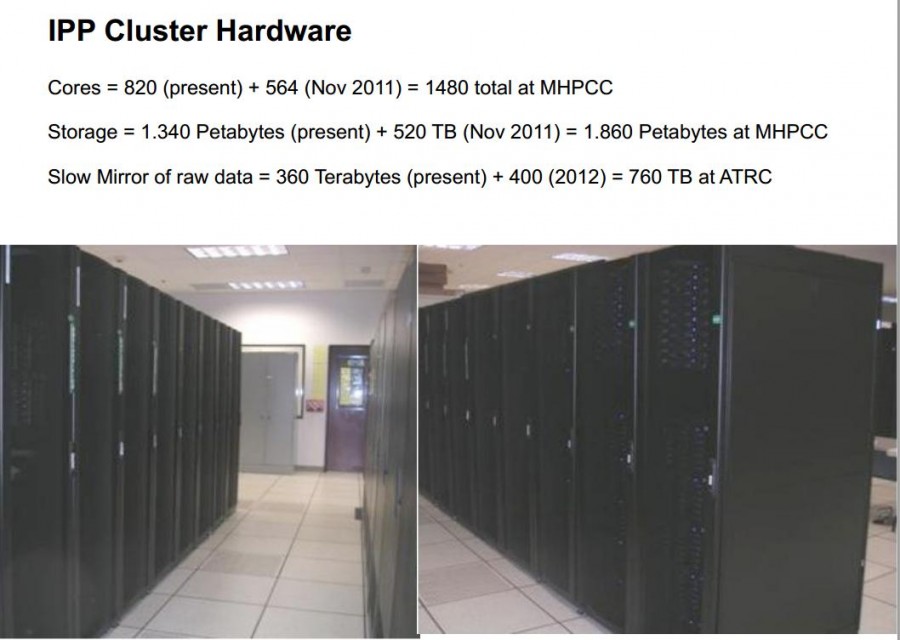
Server Pan-STARRS. Generally speaking, the photo is already 2012, today the project has expanded quite a bit, a second telescope has been added, two more are being built.
It is necessary to mention another mission - the NASA WISE space telescope and its extension NEOWISE. This device took pictures in the far infrared range, detecting asteroids by their IR glow. Generally speaking, it was initially aimed at finding asteroids beyond Neptune’s orbit — Kuiper belt objects, a scattered disk and brown dwarfs, but in the extension mission, after the coolant ended up in the telescope, and its temperature became too high The telescope was found about 200 near-Earth bodies.
As a result, over the past 30 years, the number of known near-earth asteroids has grown from ~ 50 to 15,000. Of these, 1,763 today are included in the list of potentially dangerous objects, of which none have more than 0 marks on the Turin and Palermo scales.
Is it a lot or a little? After the NEOWISE mission, NASA re-assessed the model number of asteroids as follows:
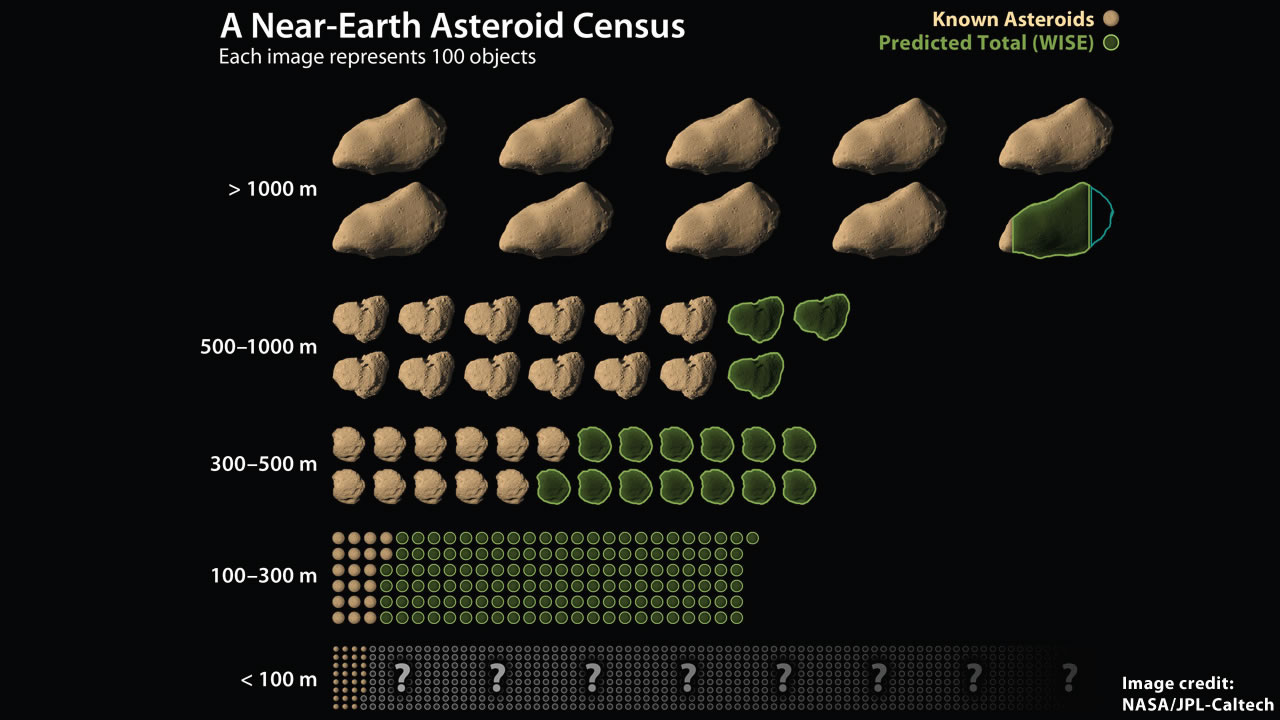
Here, the shaded image shows well-known near-earth asteroids (not only dangerous objects), the contours indicate the existing, but not yet found. The situation in 2012.
Now estimates of the proportion of asteroids detected are made through model synthesis of the population and calculation of the visibility of the bodies of this population from the Earth. Such an approach allows a good estimate of the proportion of detected bodies, not only through extrapolation of the function "size-number of bodies", but also taking into account visibility.

Red and black curve - model estimates of the number of bodies of different sizes in near-earth orbits. Blue and green dotted lines - the detected amount.
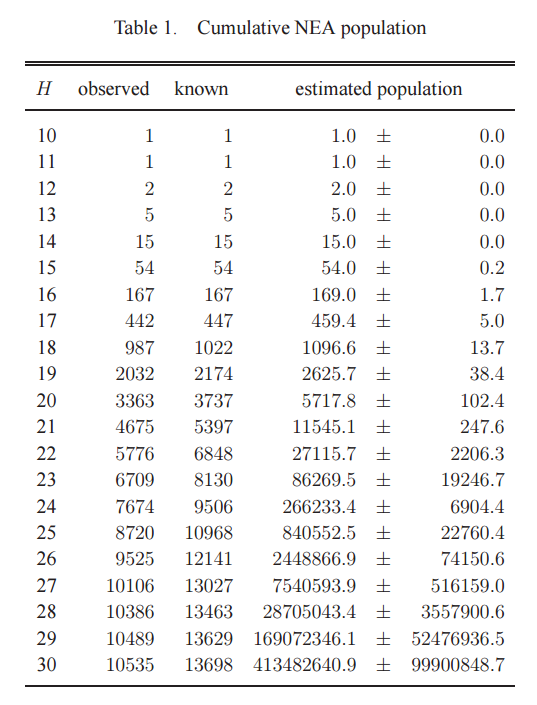
Black curve from the previous image in tabular form.
Here, in the table, the sizes of asteroids are given in units of H — the absolute magnitudes for objects in the solar system. A rough recalculation into dimensions is made according to this formula and it can be concluded from it that we know more than 90% of near-earth objects of more than 500 meters in size and about half the size of Apophis. For bodies from 100 to 150 meters, only about 35% is known.
However, we can recall that about 0.1% of dangerous objects were known to be miserable 30 years ago, so the progress is impressive.

Another estimate of the proportion of asteroids detected depending on the size. For bodies of 100 meters in size today, a few percent of the total has been detected.
However, this is not the end of the story. Today, an LSST telescope is being built in Chile, another monster telescope that will be armed with an 8-meter optics and a 3.2 gigapixel camera. For several years, starting from 2020, taking about 50 petabytes (the project’s motto “turning the skies into a database”) of LSST images, should detect ~ 100,000 near-earth asteroids, determining almost 100% of the orbits of bodies of dangerous sizes. By the way, besides the asteroids, the telescope has to give out several billion more objects and events, and that same database as a result should be 30 trillion lines, which represents a certain complexity for modern DBMS.

To perform its task, LSST has a very unusual optical design, where the third mirror is placed in the center of the first.
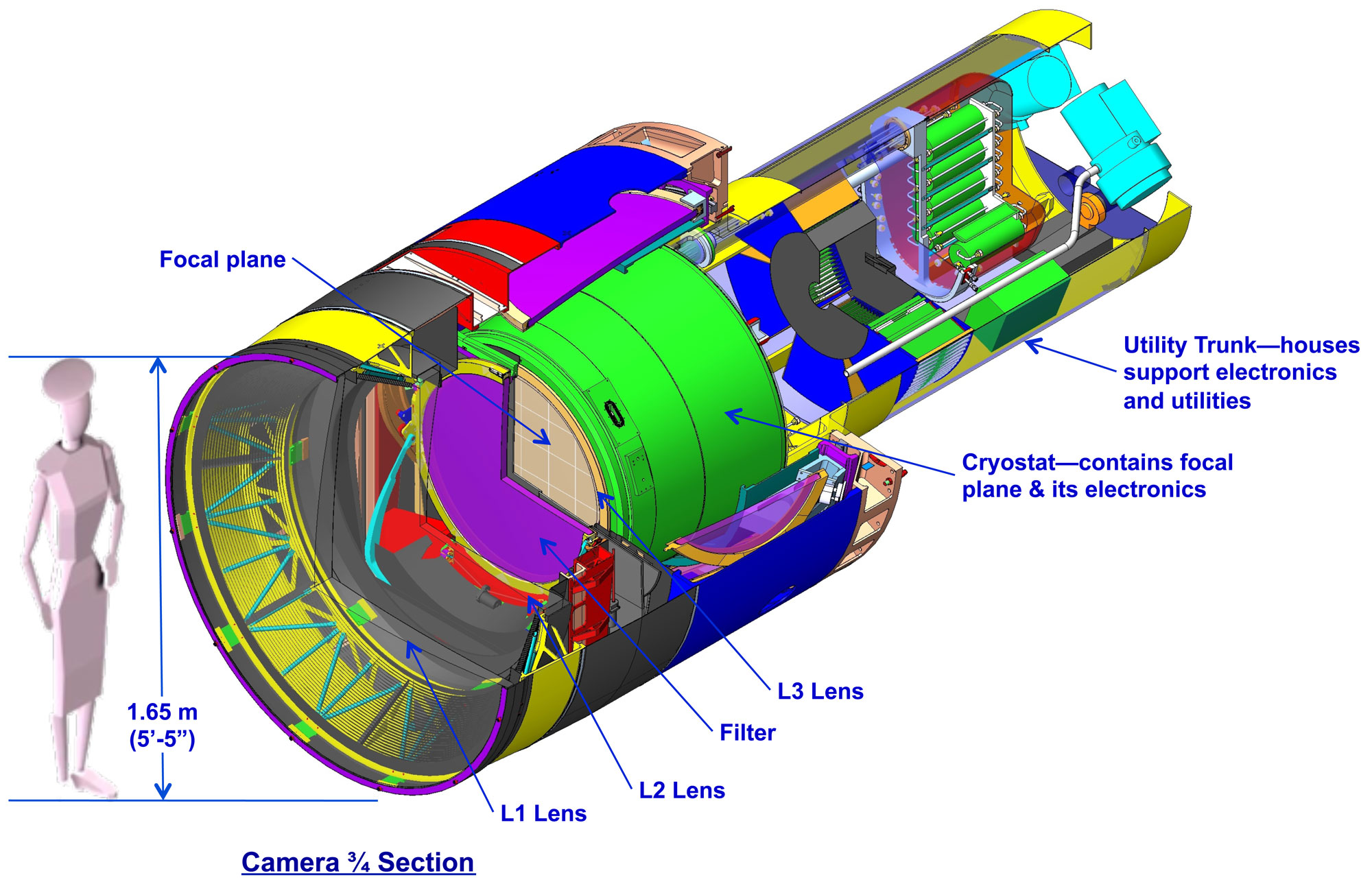
Cooled to -110 3.2 gigapixel camera with a 63 cm pupil is a working tool LSST.
Is mankind saved? Not really. There is a class of stones in orbits in relation to the Earth at a 1: 1 resonance, which are very difficult to see from Earth, there are long-period comets — usually relatively large bodies with very high velocities relative to the Earth (i.e., potentially very powerful impactors), which we can see today for no more than 2-3 years before the collision. However, in fact, for the first time in the last three centuries, since the idea of the collision of the Earth with a celestial body was born, in a few years we will have a database of trajectories of the overwhelming number of dangerous bodies carrying the Earth.
In the next part I will describe the point of view of science on the methods of influence on dangerous asteroids.
Impact

Simulation of the atmospheric explosion of the Tungus meteorite . Current estimates give the power of this impact at 5..15 megatons.
Impact is an asteroid hit (in principle of any size) on the Earth, followed by the release of its kinetic energy in the atmosphere or on the surface. The smaller the impact on energy, the more often it occurs. Impact energy is a good way to determine if a space body is dangerous for the earth or not. The first such threshold is about 100 kilotons of TNT equivalent of energy release, when an incoming asteroid (which, when it enters the atmosphere begins to be called a meteorite) ceases to be limited to falling into YouTube, and begins to bring trouble. A good example of such a threshold event is the 2014 Chelyabinsk meteorite - a small body with characteristic dimensions of 15 ... 20 meters and a mass of ~ 10 thousand tons with its shock wave caused damage to a billion rubles and injured ~ 300 people.
A compilation of the fall of the Chelyabinsk meteorite.
')
However, the Chelyabinsk meteorite aimed very well, and on the whole it didn’t particularly disrupt life even Chelyabinsk, not to mention the whole Earth. The probability of accidentally hitting a densely populated area when colliding with our planet is of the order of a few percent, so the real threshold of dangerous objects begins with a power 1000 times greater - about hundreds of megatons, the characteristic impact energy for bodies of 140-170 meters.

Unlike nuclear weapons, the energy release of meteorites is more blurred in space and time, therefore, slightly less deadly. In the photo - the explosion of a nuclear installation Ivy Mike, 10 megatons.
Such a meteor has a radius of destruction of a hundred kilometers, and successfully landed, it can stop many millions of lives. Of course, there are stones in space and a larger one - a 500 meter asteroid will cause a regional catastrophe, affecting the area thousands of kilometers from where it fell, a half mile away can erase life from a quarter of the planet’s surface, and 10 km will arrange a new mass extinction and precisely destroy civilization.
Now that we have calibrated the Armageddon level by size, we can move on to science.
Near-Earth asteroids
It is clear that only an asteroid can become an impactor whose orbit will cross the Earth's trajectory in the future. The problem is that you first need to see such an asteroid, then measure its trajectory with sufficient accuracy and model it in the future. Until the 1980s, the number of known asteroids that crossed the Earth’s orbit was dozens of, and none of them were dangerous (did not travel closer than 7.5 million kilometers from the Earth’s orbit when modeling the dynamics, say, 1000 years ahead). Therefore, the study of asteroid danger mainly focused on probabilistic calculations - how many bodies larger than 140 meters can be in orbits crossing the Earth? How often does impact occur? The danger was estimated with probability “in the next decade to get an impact with a capacity of more than 100 megatons is 10 ^ -5”, but the probability does not mean that we will not get a global catastrophe tomorrow.

The calculation of the likely frequency of impact depending on the energy. On the vertical axis, the frequency of "cases per year", on the horizontal - the power of impact in kilotons. Horizontal stripes - tolerances by. Red marks - observations of real impacts with an error.
However, qualitative and quantitative growth leads to a rapid increase in the number of near-Earth objects detected. The appearance of telescopes in the 90 CCDs (which increased their sensitivity by 1–1.5 orders of magnitude) and at the same time automatic night sky image processing algorithms led to an increase in the rate of detection of asteroids (including near-earth ones) by two orders of magnitude at the turn of the century.
Good animation of the detection and movement of asteroids from 1982 to 2012. Near-Earth asteroids are marked in red.
In 1998-1999, the LINEAR project comes into operation - two telescopes-robots with an aperture of just 1 meter, equipped with a total of 5 megapixel (later you will understand where “all”) the matrix, with the task of detecting as many asteroids and comets, h near-earth. This was not the first project of this kind (NEAT was quite successful a couple of years earlier), but the first one, specially designed for this task. The telescope was distinguished by the following features, which then become the standard:
- The special astronomical matrix of a CCD with a pixel backlight, which increased its quantum efficiency (the number of registered incident photons) to almost 100%, against 30% for standard non-astronomical ones.
- Wide-angle telescope, allowing for the night to shoot a very large surface of the sky.
- The private cadence telescope for the night 5 times photographed the same piece of sky with a gap of 28 minutes and repeated this procedure after two weeks. The exposure of the frame at the same time was only 10 seconds, after which the telescope moved to the next field.
- Special algorithms that subtracted stars from the catalog (this was an innovation) and searched for moving groups of pixels with specific angular velocities.

The original image (addition of 5 exposures with a cadence of 28 minutes) of the LINEAR telescope and after processing by the algorithm. The red circle is a near-earth asteroid, the yellow circles are the asteroids of the main belt.

The telescope project LINEAR, located in White Sands, New Mexico.
LINEAR will become the star of the first magnitude of the asteroid search, having discovered 230 thousand asteroids over the next 12 years, including 2300 crossing the Earth's orbit. Thanks to another MPC project ( Minor Planet Center ), information on the asteroid candidates found is distributed to different observatories for additional orbit measurements. In the 2000s, a similar automated survey of the Catalina sky (which will be more focused on the search for near-Earth objects and will find them hundreds per year) comes into operation.

Number of near-earth asteroids detected by different projects by year
Gradually, the estimates of the probability of Armageddon generally begin to yield to the estimates of the probability of death from a particular asteroid. Among the first hundreds, and then thousands of near-Earth asteroids, about 10% are allocated whose orbits are closer than 0.05 astronomical units from the Earth's orbit (about 7.5 million km), while the size of the asteroid must exceed 100-150 meters (the absolute magnitude of the body solar system H> 22).
At the end of 2004, NASA told the world that the asteroid Apophis 99942, discovered at the beginning of the year, with a probability of 1 to 233 will fall into the Earth in 2029. The asteroid, according to modern measurements, has a diameter of about 330 meters and an estimated mass of 40 million tons, which gives about 800 megatons of explosion energy.

Radar image of the asteroid Apophis. Measuring the trajectory with a radar at the Arecibo Observatory allowed the orbit to be refined and the probability of a collision with the Earth excluded.
Probability
However, using the example of Apophis, the very probability of a particular body to become an impactor emerged. Knowing the orbit of the asteroid with finite precision and integrating its trajectory again with finite precision, by the time of a potential collision, only an ellipse can be estimated, in which, say, 95% of the possible trajectories will occur. As the Apophis orbital parameters were refined, the ellipse decreased until planet Earth finally fell out of it, and now it is known that on April 13, 2029 the asteroid will pass at least 31200 km from the Earth’s surface (but again, this is the closest edge of the error ellipse).

An illustration of how the tube of possible orbits of the Apophis asteroid shrank at the moment of a possible collision as the orbit parameters were refined. As a result, the Earth was not affected.

Another interesting illustration of Apophis is the calculation of possible collision points (given the uncertainty) for a collision in 2036. It can be seen, by the way, that the trajectory passed near the site of the fall of the Tungussky meteorite.
By the way, for a quick assessment of the relative danger of near-earth asteroids, two scales were developed - simple Turin and more complex Palermo . Turin simply multiplies the probability of collision and the size of the estimated body, assigning it a value from 0 to 10 (for example, Apophis at the peak of the probability of collision had 4 points), and Palermo calculates the logarithm of the ratio of the probability of impact of a particular body from today to the possible collisions.

At the same time, positive values on the Palermo scale mean that a single body becomes a more significant potential source of catastrophe than all the others - open and undiscovered together. Another important point of the Palermo scale is the applied convolution of the probability of impact and its energy, giving a rather counterintuitive curve of the degree of risk versus the size of the asteroid - yes, 100 meter stones seem incapable of causing significant damage, but they fall a lot on the whole a greater number of potential victims than 1.5 kilometer “killers of civilizations”.
However, let us return to the history of the detection of near-Earth asteroids and in the middle of them potentially dangerous objects. In 2010, the first Pan-STARRS telescope came into operation, with an extra-wide telescope with an aperture of 1.8 meters, equipped with a matrix of 1,400 megapixels!

Photo of the Andromeda galaxy from the Pan-STARRS 1 telescope, allowing to evaluate its wide angle. For comparison, a full moon is drawn in the field with colored squares - the “usual” field of view of large astronomical telescopes.
Unlike LINEAR, he takes 30 second shots with a depth of 22 stars. (i.e., it could detect an asteroid measuring 100-150 meters at a distance of 1 astronomical unit, against the kilometer limit at such a distance for LINEAR), and a high-performance server (1,480 cores and 2.5 petabyte of hard drives) turns 10 terabyte to the list of transient phenomena. It should be noted here that the main purpose of Pan-STARRS is not the search for near-earth objects, but star and galactic astronomy is the search for changes in the sky, for example, distant supernovae, or catastrophic events in close binary systems. However, hundreds of new near-Earth asteroids were found in this telescope-nonsense for the year.

Server Pan-STARRS. Generally speaking, the photo is already 2012, today the project has expanded quite a bit, a second telescope has been added, two more are being built.
It is necessary to mention another mission - the NASA WISE space telescope and its extension NEOWISE. This device took pictures in the far infrared range, detecting asteroids by their IR glow. Generally speaking, it was initially aimed at finding asteroids beyond Neptune’s orbit — Kuiper belt objects, a scattered disk and brown dwarfs, but in the extension mission, after the coolant ended up in the telescope, and its temperature became too high The telescope was found about 200 near-Earth bodies.
As a result, over the past 30 years, the number of known near-earth asteroids has grown from ~ 50 to 15,000. Of these, 1,763 today are included in the list of potentially dangerous objects, of which none have more than 0 marks on the Turin and Palermo scales.
Many asteroids
Is it a lot or a little? After the NEOWISE mission, NASA re-assessed the model number of asteroids as follows:

Here, the shaded image shows well-known near-earth asteroids (not only dangerous objects), the contours indicate the existing, but not yet found. The situation in 2012.
Now estimates of the proportion of asteroids detected are made through model synthesis of the population and calculation of the visibility of the bodies of this population from the Earth. Such an approach allows a good estimate of the proportion of detected bodies, not only through extrapolation of the function "size-number of bodies", but also taking into account visibility.

Red and black curve - model estimates of the number of bodies of different sizes in near-earth orbits. Blue and green dotted lines - the detected amount.

Black curve from the previous image in tabular form.
Here, in the table, the sizes of asteroids are given in units of H — the absolute magnitudes for objects in the solar system. A rough recalculation into dimensions is made according to this formula and it can be concluded from it that we know more than 90% of near-earth objects of more than 500 meters in size and about half the size of Apophis. For bodies from 100 to 150 meters, only about 35% is known.
However, we can recall that about 0.1% of dangerous objects were known to be miserable 30 years ago, so the progress is impressive.

Another estimate of the proportion of asteroids detected depending on the size. For bodies of 100 meters in size today, a few percent of the total has been detected.
However, this is not the end of the story. Today, an LSST telescope is being built in Chile, another monster telescope that will be armed with an 8-meter optics and a 3.2 gigapixel camera. For several years, starting from 2020, taking about 50 petabytes (the project’s motto “turning the skies into a database”) of LSST images, should detect ~ 100,000 near-earth asteroids, determining almost 100% of the orbits of bodies of dangerous sizes. By the way, besides the asteroids, the telescope has to give out several billion more objects and events, and that same database as a result should be 30 trillion lines, which represents a certain complexity for modern DBMS.

To perform its task, LSST has a very unusual optical design, where the third mirror is placed in the center of the first.

Cooled to -110 3.2 gigapixel camera with a 63 cm pupil is a working tool LSST.
Is mankind saved? Not really. There is a class of stones in orbits in relation to the Earth at a 1: 1 resonance, which are very difficult to see from Earth, there are long-period comets — usually relatively large bodies with very high velocities relative to the Earth (i.e., potentially very powerful impactors), which we can see today for no more than 2-3 years before the collision. However, in fact, for the first time in the last three centuries, since the idea of the collision of the Earth with a celestial body was born, in a few years we will have a database of trajectories of the overwhelming number of dangerous bodies carrying the Earth.
In the next part I will describe the point of view of science on the methods of influence on dangerous asteroids.
Source: https://habr.com/ru/post/400317/
All Articles